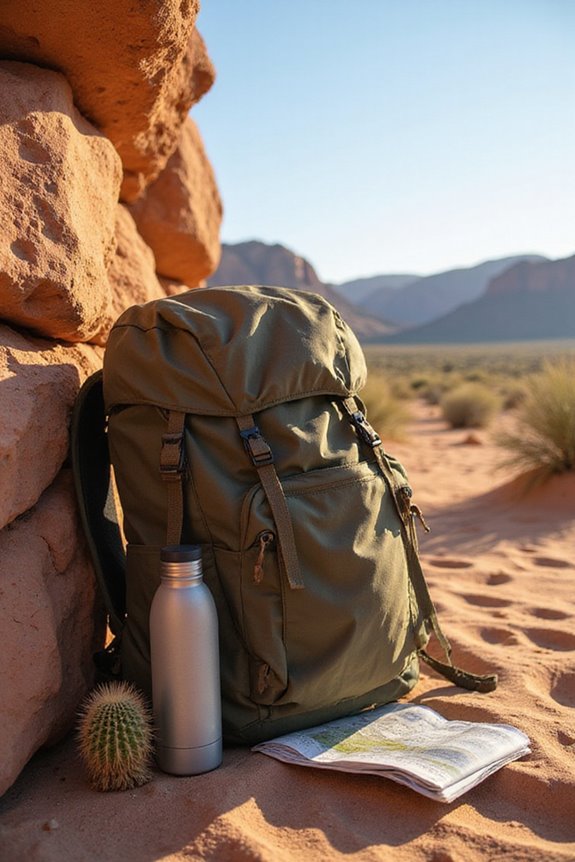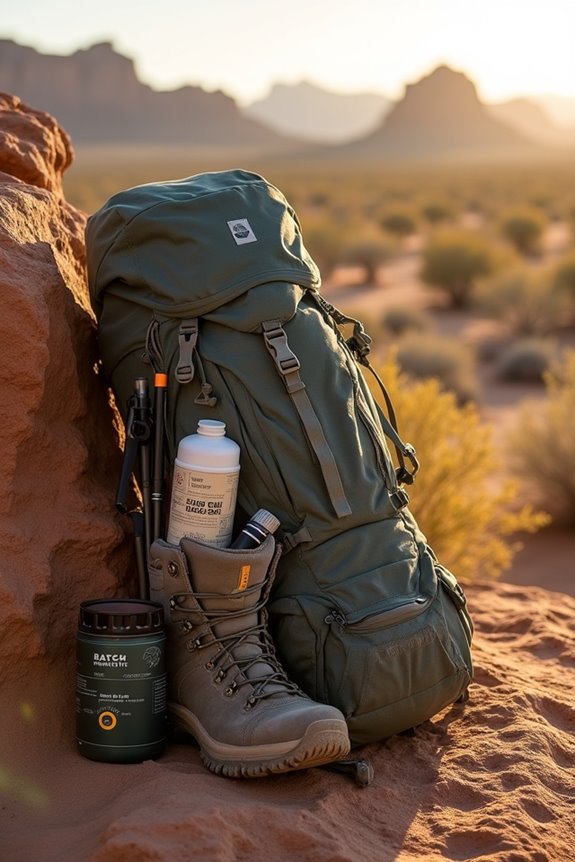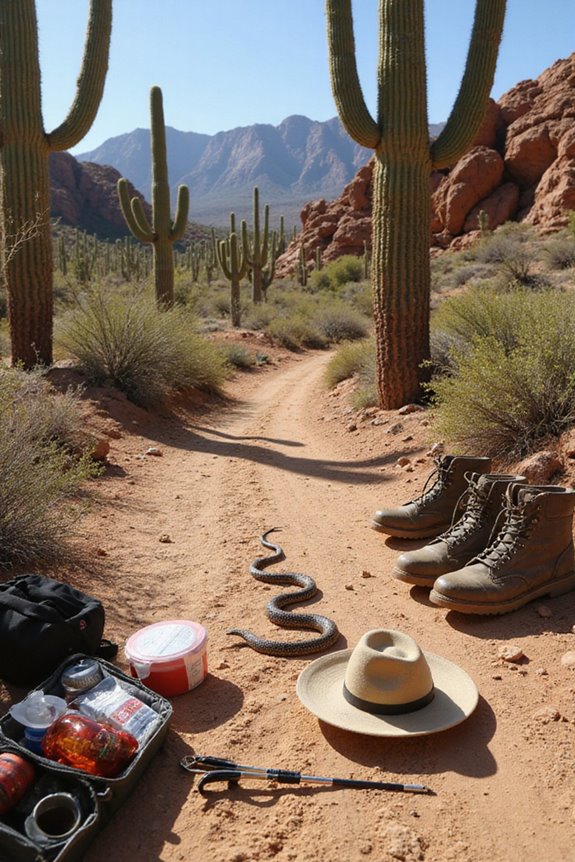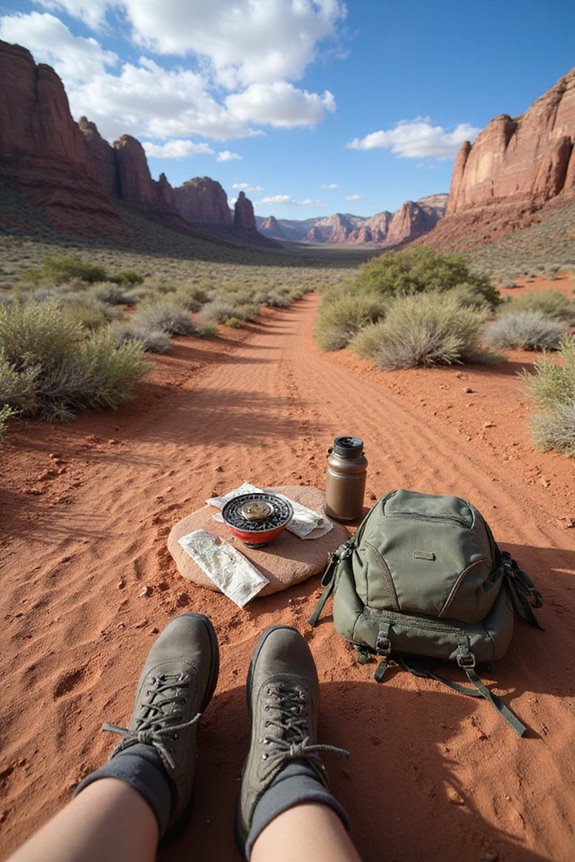We’ve all marveled at the stunning beauty of desert landscapes, but if we want to keep them thriving, we’ve got to practice Leave No Trace principles! These fragile ecosystems are home to unique plants and wildlife that rely on their delicate soils. Simply put, our actions matter! By sticking to trails and packing out all our trash, we guarantee that future adventurers can enjoy these magical places just as we did. Trust me, there’s so much more to discover about preserving our desert treasures!
Key Takeaways
- Leave No Trace principles help protect fragile desert ecosystems and their unique biodiversity from human impact.
- Responsible practices prevent soil degradation and maintain the delicate biocrusts vital for moisture retention.
- Following these principles preserves natural beauty and minimizes waste, ensuring a clean environment for future visitors.
- Respecting wildlife by keeping a safe distance fosters their well-being and supports healthy ecosystems.
- Educating visitors on sustainable practices promotes stewardship and enhances the overall outdoor experience across generations.
Understanding Desert Ecosystems
When we wander into the vast expanses of desert ecosystems, we’re stepping into a world that’s as enchanting as it is challenging. Those sun-baked landscapes are home to incredible desert adaptations that let plants and animals thrive where water’s scarce and temperatures swing wildly. Think succulents storing precious moisture and critters like the clever fennec fox, skirting the heat by taking the night shift. Just as survival guides provide essential knowledge for handling unexpected situations in the wilderness, understanding desert ecosystems offers critical insights for safe exploration. We feel the magic of ecological interactions, from the buzz of pollinators to the whispers of the wind shaping rocky terrain. Each step on the trail reveals how these unique organisms intertwine. So, let’s embrace the freedom of the outdoors, understanding and respecting these fascinating ecosystems while we adventure through their beauty.
The Fragility of Desert Soils

As we step into the enchanting desert, it’s easy to forget that beneath our feet lies an incredibly delicate ecosystem. The soil here is a marvel, especially with its fragile biocrust, which holds everything together. This thin layer, made up of lichens and mosses, plays a huge role in soil stability and moisture retention.
Yet, it’s so easily destroyed by our footsteps or vehicle tracks. Imagine shattering something so delicate—a little pressure can lead to big consequences. Without biocrusts, we witness increased erosion, less plant life, and fewer habitats for wildlife. So, let’s honor this wonder by sticking to durable surfaces. That way, we can roam freely while preserving the beauty beneath our feet! Taking lightweight hiking backpacks can help minimize your impact while allowing you to carry all necessary items for responsible desert exploration.
Importance of Waste Management in Arid Environments
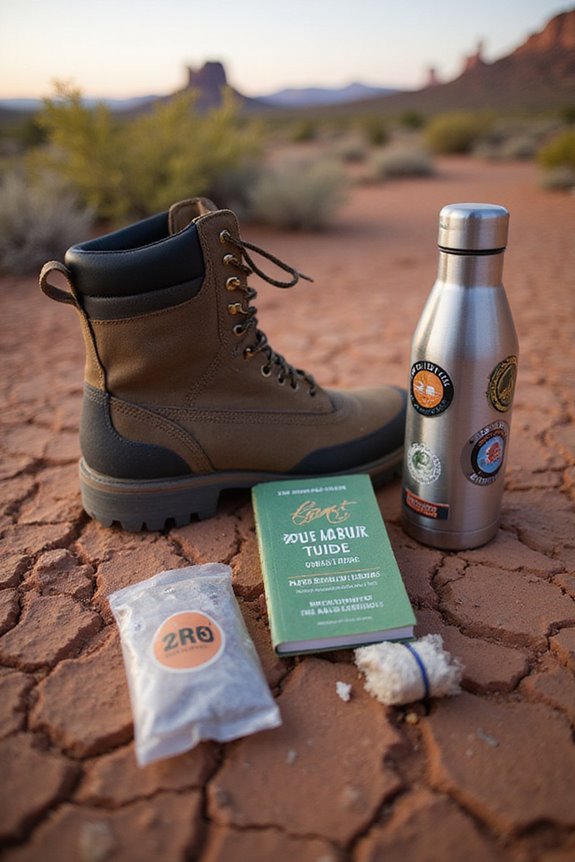
Beneath the vast, sun-soaked sky of the desert, where every step can feel like walking on a tapestry of life, there’s another side to our outdoor adventures that we can’t overlook: waste management. In these fragile environments, waste decomposition takes ages—years, even decades. That’s why we must prioritize pollution prevention! With just a scrap of trash left behind disrupting the stunning visuals and attracting non-native scavengers, our beloved wild spaces can spiral into chaos.
Let’s face it: nobody wants to hike through a landfill! Practicing “Pack It In, Pack It Out” helps conserve our precious desert ecosystems. Using laminated checklists before your trip ensures you won’t forget essential items for proper waste disposal and environmental protection. Together, we can keep these arid landscapes thriving, ensuring they’ll be a wild escape for generations to come. Ready to join us? Let’s do this!
Conservation of Unique Desert Biodiversity
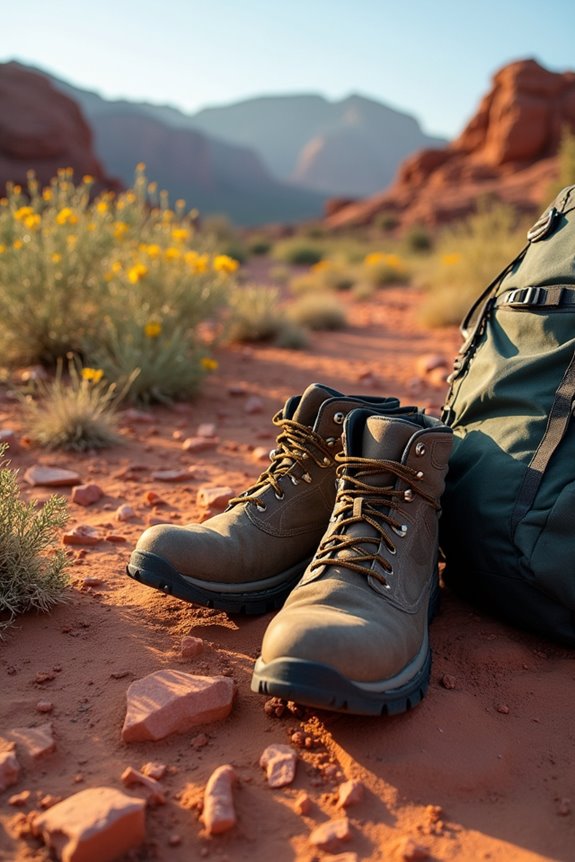
Deserts are amazing ecosystems bursting with life, but they’re also incredibly fragile, and it’s our job to protect them! Did you know these sparse landscapes are biodiversity hotspots? They hold about 25% of terrestrial vertebrate species—wow! To preserve our unique desert life, we need sound conservation strategies tailored to these extreme conditions.
We’ve seen the heartbreaking decline of desert megafauna; it’s a reality we can change together. By adopting responsible practices and reducing our footprints, we can help maintain these incredible habitats. Proper outdoor gear like Big Agnes tents can minimize your environmental impact while still allowing you to experience the natural beauty of desert landscapes. Let’s remember the Joshua trees and the majestic desert pupfish when we hike. They deserve our respect! Together, our collective actions can guarantee that our deserts thrive for generations to come. Let’s make it happen!
The Role of Leave No Trace Principles
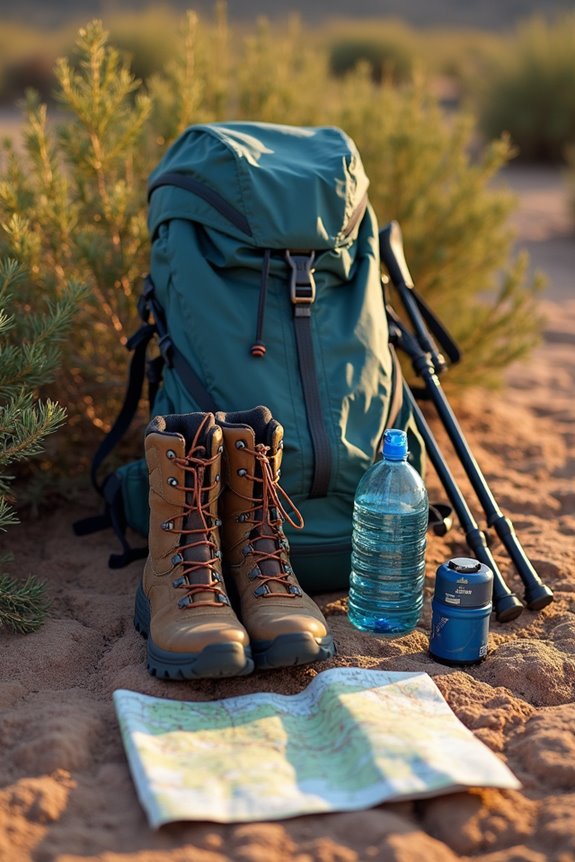
To truly appreciate the stunning beauty of our deserts, we’ve got to channel our inner outdoor stewards. Embracing Leave No Trace desert principles means being mindful of our fragile surroundings. Those delicate soils? They don’t bounce back easily, so let’s stick to durable surfaces like rock or sand instead of trampling on precious desert vegetation.
When it comes to waste management, we should pack out all trash and even those sneaky snack wrappers. Trust me, they stick around for decades in the desert! And let’s remember to respect wildlife by keeping our distance; they’re adaptive but sensitive.
We can explore freely and responsibly while allowing these breathtaking landscapes to thrive. Together, let’s guarantee our footprints are light and our impact, minimal! For women concerned about bathroom breaks in remote desert areas, consider bringing urination devices that allow for standing relief without disturbing sensitive ecosystems.
Respecting Water Sources for Wildlife
While exploring the breathtaking deserts, we can’t forget about the little oases that are crucial for wildlife survival. These tiny water sources, like tinajas and charcos, are more than just pretty spots—they’re life-savers! When we respect water availability, we’re helping creatures like the endangered Sonoran pronghorn and vibrant migratory birds. Their behavior hinges on these precious pools, influencing where they roam and how they thrive.
Imagine witnessing a tadpole’s metamorphosis, but what if that water disappears too soon? That’s why it’s essential to tread lightly. Let’s camp at least 200 feet from these gems. By protecting water sources, we’re not just preserving ecosystems; we’re ensuring future generations can enjoy the enchanting dance of desert wildlife!
Impact of Human Activity on Desert Landscapes
When we marvel at the stunning beauty of the desert, it’s easy to forget that our actions can leave lasting marks on these delicate landscapes. From overgrazing to unmanaged foot traffic, human impacts can lead to desert degradation, soil erosion, and even biodiversity loss. Let’s face it: when we trample off-trail, we’re not just creating a shortcut; we’re accelerating erosion and making a mess of essential nutrient cycling. Plus, invasive species take advantage of our careless habits, replacing native plants and disrupting ecosystem stability. Our beloved desert ecosystems have slow recovery times, making it important for us to practice responsible land management. By being mindful, we can preserve the magic of these landscapes for future adventurers—because nobody wants to hike over decades-old boot prints!
Noise and Light Pollution in Desert Areas
As we step into the mesmerizing expanse of the desert, it’s easy to get lost in the breathtaking vistas and star-studded skies. But let’s not forget that our noise impacts and light effects can really jolt this delicate ecosystem. Those raucous sounds from our vehicles disturb desert critters, causing stress and altering their behavior. And those bright, unnatural lights? They mess with reproduction cycles and can even lead to population declines. Just imagine trying to spot a sneaky predator under a floodlight — not ideal! By keeping our voices down and our lights dim, we support the vibrant wildlife and preserve the enchanting beauty of the desert. Let’s explore while respecting this unique land, ensuring it thrives for generations to come!
Ethical Considerations for Desert Recreation
It’s hard to resist the allure of the desert, where stunning landscapes beckon us to explore. But let’s remember, our adventures come with responsibilities. Engaging in ethical behavior and sustainable practices is essential to preserving this fragile environment. When we choose to stick to established trails, we protect important habitats and minimize our footprint. It’s like giving nature a high-five instead of a kick!
Supporting Future Visitors Through Responsible Practices
Supporting future visitors through responsible practices is not just a noble cause; it’s a commitment to ensuring that our beloved desert landscapes remain pristine for generations to come. When we prioritize visitor education, we empower each other to become stewards of this fragile ecosystem. By practicing responsible stewardship—like minimizing our footprints and disposing of waste properly—we protect delicate soils and enhance the experience for those who’ll come after us.
Let’s face it: nobody wants to hike past litter or see fire scars tarnishing the view. By adopting Leave No Trace principles, we can maintain that wild beauty. Together, we’re not just preserving a landscape; we’re creating memories and adventures for future explorers. So, let’s keep our deserts wild and welcoming!
Frequently Asked Questions
What Are the Specific LNT Principles for Desert Camping?
When we camp in the desert, we must respect desert plants and ecological balance. By following Leave No Trace principles, we preserve the freedom to explore while ensuring future generations can enjoy these astonishing landscapes as we do.
How Can I Identify Durable Surfaces for Camping in Deserts?
When we’re out camping, we can identify durable surfaces by looking for bare rock, gravel, or firm sand. Utilizing smart camping techniques helps keep these areas intact, allowing us to enjoy the freedom of nature responsibly.
What Are the Risks of Leaving Food Scraps in the Desert?
Leaving food waste in the desert attracts wildlife, disrupting their natural behaviors and leading to conflicts. It’s essential we keep our camps clean to respect the freedom and health of both the animals and our environment.
How Do Human Activities Affect Desert Wildlife Behavior?
Human activities disrupt desert wildlife behavior considerably; as we roam, we create habitat disturbances that skew predator interactions and stress animals. Let’s cherish their space and promote freedom while respecting the delicate balance of their lives.
What Actions Can I Take to Minimize Noise in Desert Areas?
Like whispers in a library, we can embrace noise reduction in deserts. By practicing sound awareness—traveling quietly on trails, minimizing vehicle use, and respecting wildlife—we preserve this serene environment for future generations to enjoy together.

